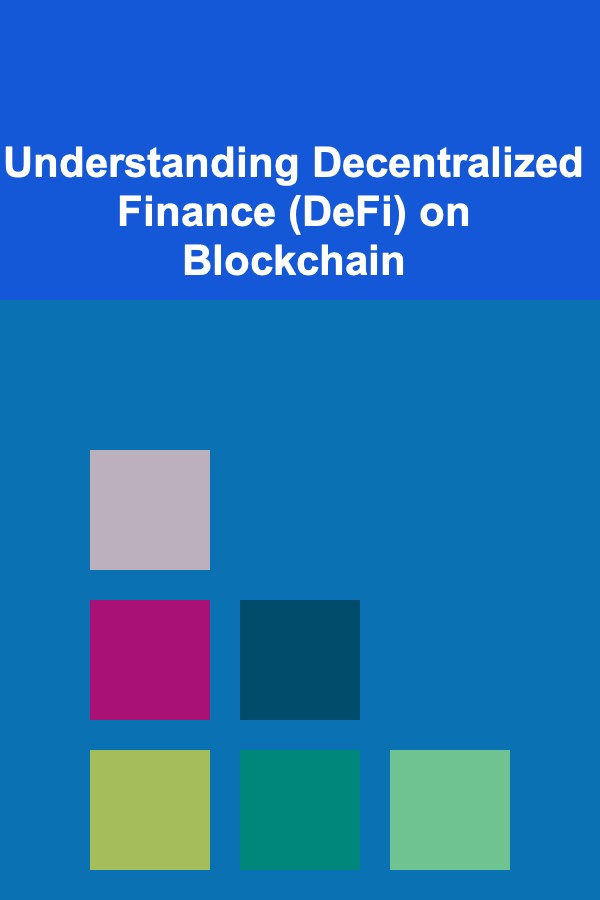
Understanding Decentralized Finance (DeFi) on Blockchain
ebook include PDF & Audio bundle (Micro Guide)
$12.99$10.99
Limited Time Offer! Order within the next:

Decentralized Finance (DeFi) has emerged as one of the most transformative and disruptive applications of blockchain technology. It aims to recreate and improve upon traditional financial systems in a permissionless, transparent, and often more efficient manner. Understanding DeFi requires grasping its core principles, underlying technologies, key components, potential benefits, and inherent risks.
What is Decentralized Finance (DeFi)?
At its core, DeFi is a financial system built on blockchain networks, primarily Ethereum. Unlike traditional finance (TradFi), which relies on centralized intermediaries like banks, exchanges, and payment processors, DeFi leverages decentralized protocols and smart contracts to automate and execute financial functions. This allows users to interact directly with financial services without the need for intermediaries. The "decentralized" aspect refers to the distribution of control and decision-making power across a network of participants, rather than being concentrated in a single entity.
Here's a breakdown of the key characteristics that define DeFi:
- Decentralization: Control is distributed across a network, eliminating single points of failure and censorship.
- Permissionless: Anyone can access and use DeFi applications without requiring approval from a central authority. This promotes inclusivity and financial accessibility.
- Transparency: All transactions and smart contract code are publicly auditable on the blockchain, fostering trust and accountability.
- Immutability: Once deployed, smart contracts cannot be altered, ensuring predictable and reliable operation. This also introduces challenges in managing bugs and vulnerabilities.
- Composability: DeFi protocols are designed to be modular and interoperable, allowing them to be easily combined and built upon. This creates a vibrant and innovative ecosystem.
The Foundation: Blockchain Technology
DeFi's existence is entirely dependent on blockchain technology. Blockchains provide the secure, transparent, and immutable infrastructure necessary for DeFi applications to function. Here's how blockchain underpins DeFi:
- Distributed Ledger Technology (DLT): The blockchain serves as a shared, distributed ledger that records all transactions. This eliminates the need for a central record-keeper, reducing the risk of manipulation and fraud.
- Cryptography: Cryptographic techniques, such as hashing and digital signatures, are used to secure transactions and verify identities. This ensures the integrity and authenticity of data on the blockchain.
- Smart Contracts: Self-executing contracts written in code that automatically enforce the terms of an agreement. These are the building blocks of DeFi applications, automating processes like lending, borrowing, and trading.
- Tokens: Digital assets that represent various forms of value on the blockchain, such as cryptocurrencies, stablecoins, and governance tokens. These are used to facilitate transactions and incentivize participation in DeFi protocols.
While various blockchain platforms can potentially host DeFi applications, Ethereum has emerged as the dominant platform due to its robust smart contract capabilities and large developer community. However, other blockchains, like Binance Smart Chain, Solana, Avalanche, and Polkadot, are also gaining traction in the DeFi space, often offering faster transaction speeds and lower fees.
Key Components and Applications of DeFi
DeFi encompasses a wide range of applications and protocols that aim to replicate and improve upon traditional financial services. Here are some of the most prominent components:
Decentralized Exchanges (DEXs)
DEXs allow users to trade cryptocurrencies directly with each other without relying on a central intermediary like Coinbase or Binance. They operate using automated market makers (AMMs) or order book models.
- Automated Market Makers (AMMs): AMMs use algorithms to automatically determine the price of assets based on the ratio of tokens in liquidity pools. Users provide liquidity to these pools and earn fees from trades. Examples include Uniswap, SushiSwap, and PancakeSwap.
- Order Book DEXs: These DEXs mimic the traditional order book model used by centralized exchanges, matching buy and sell orders directly. Examples include dYdX and Serum.
Advantages of DEXs:
- Non-Custodial: Users retain control of their funds at all times.
- Permissionless: Anyone can list and trade assets.
- Transparency: All transactions are recorded on the blockchain.
- Resistant to Censorship: Difficult to shut down or censor transactions.
Disadvantages of DEXs:
- Slippage: Price impact due to large trades.
- Impermanent Loss (for AMM liquidity providers): The risk of losing value when providing liquidity to an AMM pool due to price fluctuations.
- Front-Running: Exploiting knowledge of pending transactions to profit.
- Complexity: Can be more complex to use than centralized exchanges.
Lending and Borrowing Platforms
DeFi lending and borrowing platforms allow users to lend out their cryptocurrencies and earn interest, or borrow cryptocurrencies by providing collateral. These platforms use smart contracts to automate the lending and borrowing process.
- Over-Collateralization: Borrowers typically need to provide collateral worth more than the amount they are borrowing to mitigate the risk of default.
- Interest Rates: Interest rates are often determined algorithmically based on supply and demand.
- Flash Loans: Uncollateralized loans that must be repaid within the same transaction block. These are often used for arbitrage or liquidations.
Examples: Aave, Compound, MakerDAO.
Advantages of DeFi Lending and Borrowing:
- Accessibility: Open to anyone with cryptocurrency.
- Transparency: Interest rates and collateral requirements are publicly available.
- Efficiency: Automated processes reduce costs and increase speed.
- Potential for Higher Yields: Can offer higher interest rates than traditional savings accounts.
Disadvantages of DeFi Lending and Borrowing:
- Smart Contract Risk: Vulnerability to bugs or exploits in the smart contract code.
- Liquidation Risk: Collateral can be liquidated if its value falls below a certain threshold.
- Volatility: Cryptocurrency prices are highly volatile, which can impact the value of collateral and loan positions.
Stablecoins
Stablecoins are cryptocurrencies designed to maintain a stable value relative to a specific asset, typically the US dollar. They play a crucial role in DeFi by providing a stable medium of exchange and a hedge against volatility.
- Fiat-Collateralized Stablecoins: Backed by reserves of fiat currency held in custody. Examples include Tether (USDT) and USD Coin (USDC).
- Crypto-Collateralized Stablecoins: Backed by reserves of other cryptocurrencies. Examples include Dai (DAI) and sUSD.
- Algorithmic Stablecoins: Use algorithms and smart contracts to maintain their peg. These are often more complex and riskier than other types of stablecoins. Examples include Frax and Empty Set Dollar (ESD).
Advantages of Stablecoins:
- Stability: Reduce volatility compared to other cryptocurrencies.
- Efficiency: Facilitate faster and cheaper transactions than traditional currencies.
- Programmability: Can be integrated into smart contracts and DeFi applications.
Disadvantages of Stablecoins:
- Centralization Risk (for fiat-collateralized stablecoins): Reliance on a central entity to maintain reserves.
- Collateral Risk (for crypto-collateralized stablecoins): Vulnerability to fluctuations in the value of the collateral.
- Algorithmic Risk (for algorithmic stablecoins): Potential for failure if the algorithm is not properly designed or implemented.
Derivatives and Prediction Markets
DeFi derivatives platforms allow users to trade contracts that derive their value from underlying assets, such as cryptocurrencies, commodities, or even real-world events. Prediction markets allow users to bet on the outcome of future events.
- Perpetual Swaps: Contracts with no expiration date that allow users to trade with leverage.
- Options: Contracts that give the holder the right, but not the obligation, to buy or sell an asset at a specific price on or before a specific date.
- Prediction Markets: Platforms where users can bet on the outcome of future events, with the odds and payouts determined by the market participants.
Examples: dYdX, Synthetix, Augur.
Advantages of DeFi Derivatives and Prediction Markets:
- Access to Leverage: Magnify potential profits (and losses).
- Hedging Opportunities: Protect against price fluctuations.
- Price Discovery: Provide insights into market sentiment and expectations.
Disadvantages of DeFi Derivatives and Prediction Markets:
- High Risk: Leverage can amplify losses.
- Complexity: Derivatives can be complex to understand and trade.
- Regulatory Uncertainty: The legal and regulatory status of DeFi derivatives is still evolving.
Yield Farming and Liquidity Mining
Yield farming involves deploying cryptocurrency assets into various DeFi protocols to earn rewards, typically in the form of additional tokens. Liquidity mining is a specific type of yield farming that involves providing liquidity to AMM pools and earning rewards in the form of governance tokens.
- APY (Annual Percentage Yield): The annualized rate of return earned from yield farming.
- Governance Tokens: Tokens that give holders the right to vote on protocol governance decisions.
- Incentives: Protocols use yield farming and liquidity mining to attract users and bootstrap liquidity.
Examples: Providing liquidity to Uniswap and earning UNI tokens, staking tokens on Compound and earning COMP tokens.
Advantages of Yield Farming and Liquidity Mining:
- Potential for High Returns: Can offer significantly higher returns than traditional investments.
- Passive Income: Earn rewards by simply holding and staking cryptocurrency assets.
- Governance Participation: Influence the direction of DeFi protocols.
Disadvantages of Yield Farming and Liquidity Mining:
- Impermanent Loss: The risk of losing value when providing liquidity to an AMM pool.
- Smart Contract Risk: Vulnerability to bugs or exploits in the smart contract code.
- Complexity: Can be complex to understand and manage yield farming strategies.
- Rug Pulls: Scams where developers abandon a project and steal user funds.
Benefits of Decentralized Finance
DeFi offers several potential benefits over traditional finance:
- Financial Inclusion: Provides access to financial services for individuals and communities that are underserved by traditional banks.
- Transparency and Auditability: All transactions are publicly recorded on the blockchain, increasing transparency and reducing the potential for fraud.
- Efficiency and Automation: Smart contracts automate financial processes, reducing costs and increasing speed.
- Innovation: The composability of DeFi protocols fosters innovation and allows for the creation of new financial products and services.
- Control and Ownership: Users retain control of their funds and data.
- Global Accessibility: DeFi is accessible to anyone with an internet connection, regardless of their location.
Risks and Challenges of Decentralized Finance
Despite its potential benefits, DeFi also faces several risks and challenges:
- Smart Contract Risk: Smart contracts are vulnerable to bugs and exploits, which can lead to the loss of funds. Audits are crucial but not foolproof.
- Volatility: Cryptocurrency prices are highly volatile, which can impact the value of collateral and loan positions.
- Impermanent Loss: A risk for liquidity providers in AMMs, potentially reducing returns.
- Scalability: Some blockchain networks, like Ethereum, can struggle to handle high transaction volumes, leading to slow transaction speeds and high fees. Layer-2 scaling solutions are being developed to address this issue.
- Regulatory Uncertainty: The legal and regulatory status of DeFi is still evolving, creating uncertainty for users and developers.
- Complexity: DeFi protocols can be complex to understand and use, which can be a barrier to entry for new users.
- Security Risks: Hacks and scams are prevalent in the DeFi space, requiring users to be vigilant about security best practices.
- Centralization Concerns: While DeFi aims for decentralization, some protocols may still be controlled by a small group of individuals or entities.
The Future of DeFi
DeFi is still in its early stages of development, but it has the potential to revolutionize the financial industry. As the technology matures and the ecosystem grows, DeFi is likely to become more accessible, secure, and user-friendly. Key areas of development include:
- Layer-2 Scaling Solutions: To address scalability issues on Ethereum and other blockchains.
- Interoperability: To enable seamless interaction between different DeFi protocols and blockchain networks.
- Improved Security: To reduce the risk of hacks and exploits.
- User Experience (UX) Improvements: To make DeFi more accessible to mainstream users.
- Regulatory Clarity: To provide a clear legal framework for DeFi activities.
- Integration with Traditional Finance: To bridge the gap between DeFi and TradFi, creating new opportunities for collaboration and innovation. Real-World Asset (RWA) tokenization is a significant area of focus.
The long-term vision of DeFi is to create a more open, transparent, and accessible financial system for everyone. While challenges remain, the potential of DeFi to transform the financial landscape is undeniable. Ongoing research, development, and community engagement are essential to realizing this vision and mitigating the inherent risks.
Staying Informed and Participating Responsibly
Due to the rapidly evolving nature of DeFi and the inherent risks involved, it's crucial to stay informed and participate responsibly. Here are some tips:
- Do Your Own Research (DYOR): Thoroughly research any DeFi protocol or platform before investing or participating. Understand the underlying technology, risks, and potential rewards.
- Start Small: Begin with small amounts of capital to gain experience and understanding.
- Diversify: Don't put all your eggs in one basket. Diversify your investments across multiple DeFi protocols and asset classes.
- Use Strong Security Practices: Protect your private keys and use strong passwords. Consider using a hardware wallet.
- Stay Updated: Follow reputable news sources and thought leaders in the DeFi space to stay informed about the latest developments and risks.
- Understand Smart Contract Audits: Check if the smart contracts of a DeFi protocol have been audited by reputable security firms. While not a guarantee of safety, it provides an additional layer of security.
- Be Aware of Rug Pulls and Scams: Exercise caution and avoid projects that seem too good to be true. Look for red flags such as anonymous teams, unrealistic promises, and aggressive marketing tactics.
DeFi offers exciting opportunities, but it's important to approach it with caution and a thorough understanding of the risks involved. By staying informed, practicing responsible investing, and engaging with the community, you can navigate the DeFi landscape more effectively and contribute to its continued growth and development.

Becoming a Successful Healthcare Administrator: Best Practices for Managing Health Organizations
Read More
How To Give Difficult Feedback with Grace
Read More
The Public Affairs Manager's Playbook: Essential Techniques for Building Strong Stakeholder Relationships
Read More
How to Develop a Full-Body Workout Plan
Read More
10 Tips for Engaging Your Family in Community Service Together
Read More
10 Tips for a Career Development Checklist Focused on Soft Skills
Read MoreOther Products

Becoming a Successful Healthcare Administrator: Best Practices for Managing Health Organizations
Read More
How To Give Difficult Feedback with Grace
Read More
The Public Affairs Manager's Playbook: Essential Techniques for Building Strong Stakeholder Relationships
Read More
How to Develop a Full-Body Workout Plan
Read More
10 Tips for Engaging Your Family in Community Service Together
Read More